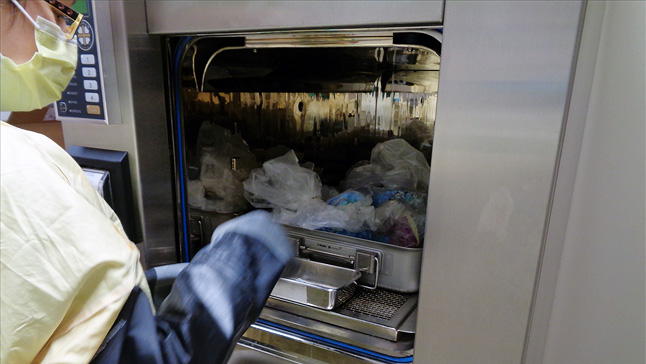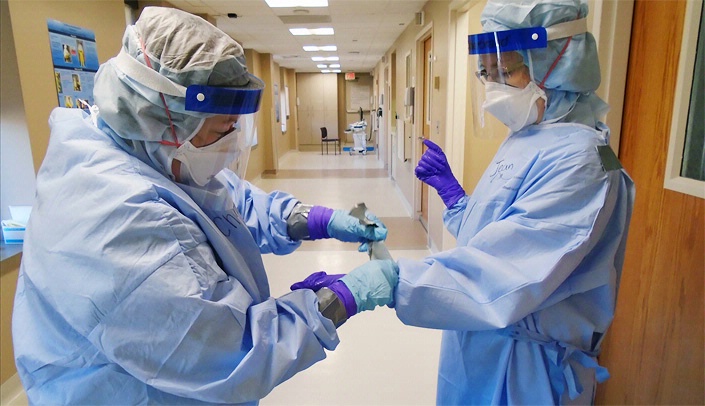Designed to handle everything from smallpox and SARS to avian influenza and Ebola, UNMC's biocontainment unit is staffed by more than 40 highly trained professionals who have special training in disaster management, cardiac life support and bioterrorism.
They work full-time in other areas of UNMC's primary clinical partner, Nebraska Medicine – but remain ready to report to the unit promptly. In the event of a public health threat, the Nebraska Department of Health and Human Services and the biocontainment unit's medical director may activate the unit.
Almost as big as a basketball court, the 4,100-square-foot area on the seventh floor of University Tower is the largest of only three such units in the country specially equipped to handle an outbreak of this nature. The others are at Emory University in Atlanta and the National Institutes of Health in Bethesda, Md.
The five patient rooms in UNMC's biocontainment unit are equipped with negative air pressure to handle airborne viruses (which Ebola is not), meaning that their exhaust fans pull in air and send it through HEPA filters with microscopic openings that trap the tiniest particles. The particles can't leave the unit and infect areas outside.
This unit itself has become a laboratory for developing best practices of safety and treatment of patients with highly infectious diseases.
The donning and doffing of personal protective equipment (PPE), always a two-person effort in the biocontainment unit, has now been adopted as a gold standard, said Shelly Schwedhelm, executive director, emergency preparedness and infection prevention, Nebraska Medicine.
"One person follows the checklist, supervises and assists with the correct order of donning and doffing while a second person puts on the gear or carefully removes it with assistance as directed," Schwedhelm said. "We found that this reduces the risk of exposure to potentially dangerous bodily fluids. It takes more time, but it's safe."

A pass-through autoclave, less than half the size of a normal refrigerator, sterilizes PPE, patient linens, scrubs and towels.
Other adjustments and improvements were made during and after the treatment of UNMC's first Ebola patient, Rick Sacra, M.D., including:
- The five-room/10-bed unit became a two-room, two-bed unit when treating Ebola patients.
- The team switched to a new electronic stethoscope that provided better sound quality and reduced contamination risks.
- A mobile laboratory was moved into the unit to speed test results, allowing physicians to more quickly adjust a patient's critical fluid and electrolyte levels. Before that, testing of specimens had been delayed for up to an hour because the main lab was across campus and required stringent and time consuming protocols to move the samples.
- Two rooms were converted into storage for extra equipment and used protective gear that was staged for the autoclave.
One of the key areas of concern related to the treatment of Ebola patients in the U.S. is waste removal. Ebola patients treated by the Nebraska team produced about 23 cubic feet – more than 50 pounds – of solid waste per day, most of which was PPE worn by health care workers.
UNMC's experts in biocontainment patient transportation and waste management issues developed procedures to safely handle the waste. Shawn Gibbs, Ph.D., professor, and John Lowe, Ph.D., assistant professor, environmental, agricultural and occupational health, UNMC College of Public Health, worked with an autoclave in the UNMC Biocontainment unit to convert category A waste – waste known or expected to contain a deadly pathogen like Ebola – into category B medical waste to enable safe disposal. This innovation allows it to be shipped more safely and at a lower cost than category A waste.
While Ebola patients were in the unit, the autoclave operated for more than 12 hours a day.
Although the CDC allowed any patient-generated liquid waste to go down the drain and be treated by the municipal plant, prior research conducted by these two industrial hygienists led them to implement an inexpensive disinfectant route.
"We conducted risk assessments on every procedure and developed alternative scenarios in case things happened – a 'what if?' list," Dr. Gibbs said.
Up to nine liters of liquid waste produced daily by Ebola patients was disposed into a toilet with hospital-grade disinfectant and held 2.5 times longer than the manufacturer recommended time before being flushed.
Because of these successful protocols and innovations, Nebraska Medicine and UNMC faculty and staff are working with the CDC and Emory University to provide training and educational resources to the staff at other U.S. hospitals that federal health officials recently designated as Ebola treatment centers, to increase the number of beds available to treat future patients.
